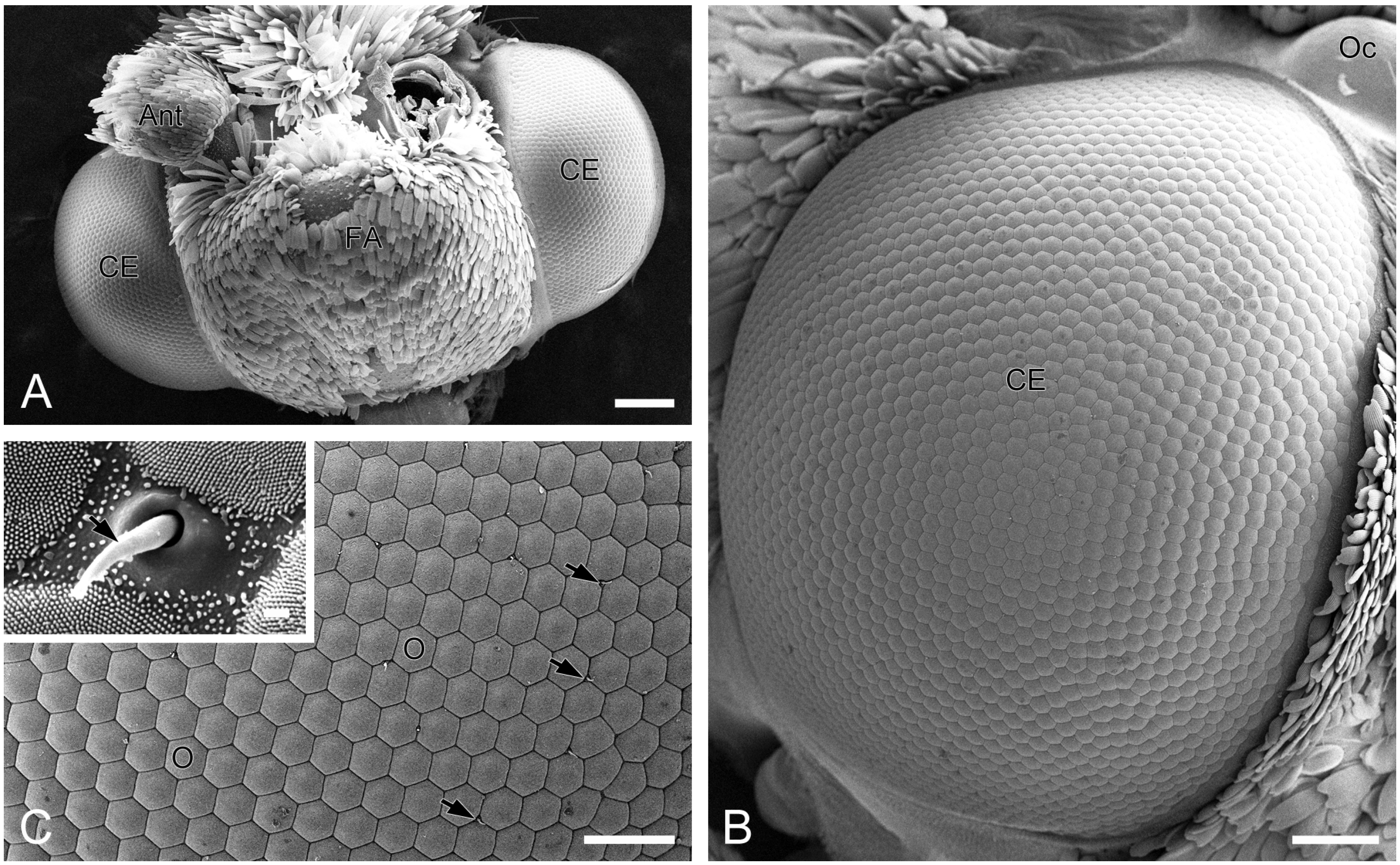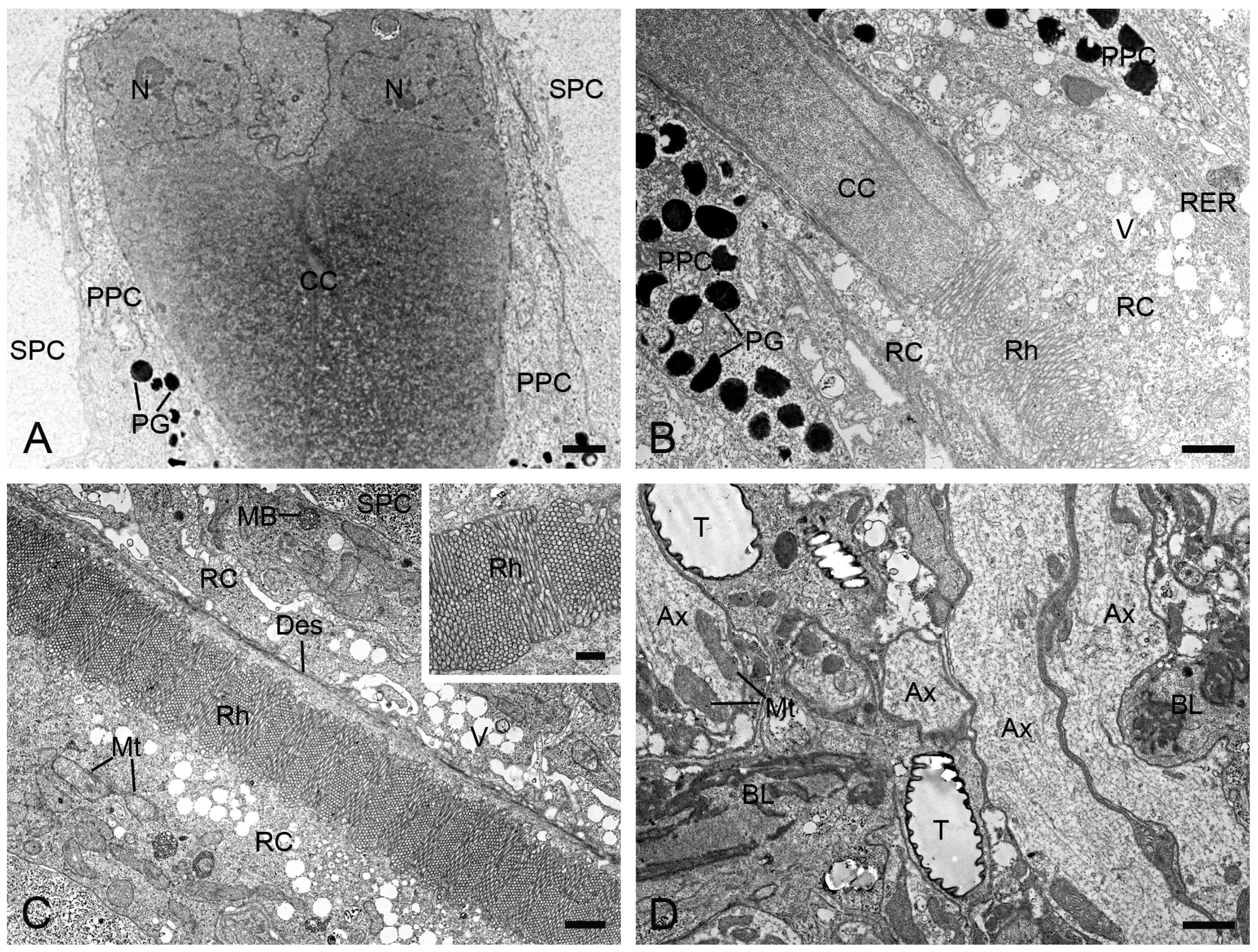Unraveling the Compound Eye Design of the Diurnal Moth Histia flabellicornis (Lepidoptera: Zygaenidae)
Simple Summary
Abstract
1. Introduction
2. Materials and Methods
2.1. Insect Collection
2.2. Scanning Electron Microscopy (SEM)
2.3. Light Microscopy (LM) and Transmission Electron Microscopy (TEM)
2.4. Data Measurement and Analysis
3. Results
3.1. External Morphology
3.2. Anatomical Structure
4. Discussion
Author Contributions
Funding
Data Availability Statement
Acknowledgments
Conflicts of Interest
References
- Warrant, E.; Kelber, A.; Kristensen, N.P. Eyes and vision. In Handbook of Zoology vol. IV 36, Lepidoptera 2; Kristensen, N.P., Ed.; Walter de Gruyter: Berlin, Germany, 2003; pp. 325–360. [Google Scholar]
- Ribi, W.A. Ultrastructure and migration of screening pigments in the retina of Pieris rapae L. (Lepidoptera, Pieridae). Cell Tissue Res. 1978, 191, 57–73. [Google Scholar] [CrossRef]
- Arikawa, K. The eyes and vision of butterflies. J. Physiol. 2017, 595, 5457–5464. [Google Scholar] [CrossRef]
- Liénard, M.A.; Bernard, G.D.; Allen, A.; Lassance, J.M.; Song, S.; Childers, R.R.; Yu, N.; Ye, D.; Stephenson, A.; Valencia-Montoya, W.A.; et al. The evolution of red color vision is linked to coordinated rhodopsin tuning in lycaenid butterflies. Proc. Natl. Acad. Sci. USA 2021, 118, e2008986118. [Google Scholar] [CrossRef]
- Chen, Q.X.; Lyu, Q.H.; Chen, Y.W.; Song, Y.Q. Phylogenetic implications based on an ultrastructural study with emphasis on the tracheal system of the compound eyes of three species of nymphalid butterflies. Arthropod Struct. Dev. 2023, 72, 101230. [Google Scholar] [CrossRef]
- Ling, J.; Chen, H.Y.; Xu, T.; Huang, Y.T.; Huang, D.M.; Zheng, X.L. A micro-anatomical investigation of dark and light-adapted eyes of Chilades pandava (Lepidoptera: Lycaenidae). Fla. Entomol. 2025, 108, 20240058. [Google Scholar] [CrossRef]
- Nilsson, D.E. Optics and evolution of the compound eye. In Facets of Vision; Stavenga, D.G., Hardie, R.C., Eds.; Springer: Berlin, Germany, 1989; pp. 30–73. [Google Scholar]
- Stone, G.C.; Koopowitz, H. The ultrastructural organization of the visual system of the wax moth, Galleria mellonella: The retina. Cell Tiss. Res. 1976, 174, 519–531. [Google Scholar] [CrossRef]
- Meyer-Rochow, V.B.; Lau, T.F. Sexual dimorphism in the compound eye of the moth Operophtera brumata (Lepidoptera, Geometridae). Invertebr. Biol. 2008, 127, 201–216. [Google Scholar] [CrossRef]
- Chen, Q.X.; Chen, Y.W.; Li, W.L. Ultrastructural comparison of the compound eyes of the Asian corn borer Ostrinia furnacalis (Lepidoptera: Crambidae) under light/dark adaptation. Arthropod Struct. Dev. 2019, 53, 100901. [Google Scholar] [CrossRef]
- Chen, Q.X.; Han, Y. Retinal adaptation in response to light and dark regimes in the oriental armyworm Mythimna separata (Lepidoptera: Noctuidae). Insects 2024, 15, 135. [Google Scholar] [CrossRef]
- Han, Y.; Chen, Q.X. Ultrastructural and light/dark adaptational characteristics of the compound eyes in the fall armyworm, Spodoptera frugiperda (Lepidoptera: Noctuidae). Arthropod Struct. Dev. 2025, 86, 101449. [Google Scholar] [CrossRef]
- Yack, J.E.; Johnson, S.E.; Brown, S.G.; Warrant, E.J. The eyes of Macrosoma sp. (Lepidoptera: Hedyloidea): A nocturnal butterfly with superposition optics. Arthropod Struct. Dev. 2007, 36, 11–22. [Google Scholar] [CrossRef]
- Horridge, G.A.; Giddings, C.; Stange, G. The superposition eye of skipper butterflies. Proc. R. Soc. Lond. B 1972, 182, 457–495. [Google Scholar]
- Horridge, G.A.; McLean, M.; Stangem, G.; Lillywhite, P.G. A diurnal moth superposition eye with high resolution Phalaenoides tristifica (Agaristidae). Proc. R. Soc. Lond. B 1977, 196, 233–250. [Google Scholar]
- Horridge, G.A.; Marcelja, L.; Jahnke, R. Retinula cell responses in a moth superposition eye. Proc. R. Soc. Lond. B 1983, 220, 47–68. [Google Scholar]
- Eguchi, E. Retinular fine structure in compound eyes of diurnal and nocturnal sphingid moths. Cell Tiss. Res. 1982, 223, 29–42. [Google Scholar] [CrossRef]
- Warrant, E.; Bartsch, K.; Günther, C. Physiological optics in the hummingbird hawkmoth: A compound eye without ommatidia. J. Exp. Biol. 1999, 202, 497–511. [Google Scholar] [CrossRef]
- Eby, C.; Weis, M.; Gardiner, M.G.T.; Judd, G.J.R.; Gries, G. Spectral efficiency and microstructure of the compound eyes of Synanthedon myopaeformis (Lepidoptera: Sesiidae). Can. Entomol. 2013, 145, 529–538. [Google Scholar] [CrossRef]
- Pirih, P.; Ilić, M.; Rudolf, J.; Arikawa, K.; Stavenga, D.G.; Belušič, G. The giant butterfly-moth Paysandisia archon has spectrally rich apposition eyes with unique light-dependent photoreceptor dynamics. J. Comp. Physiol. A 2018, 204, 639–651. [Google Scholar] [CrossRef]
- Huang, B.K. A study on the bionomic characteristics and control of the Bischofia burnet Histia rhodope Cramer (Lepidoptera, Zygaenidae). J. Fujian Agr. Coll. 1980, 1, 61–79. [Google Scholar]
- Lu, Z.Y.; Jiang, W.B.; Weng, M.L. Landscape characters of Bischofia polycarpa and its exploitation and application. Acta Agr. Jiangxi 2009, 21, 64–67. [Google Scholar]
- Paulus, H.F. Phylogeny of the Myriapoda-Crustacea-Insecta: A new attempt using photoreceptor structure. J. Zool. Syst. Evol. Res. 2000, 38, 189–208. [Google Scholar] [CrossRef]
- Kittelmann, M.; McGregor, A.P. Looking across the gap: Understanding the evolution of eyes and vision among insects. BioEssays 2024, 46, 2300240. [Google Scholar] [CrossRef]
- Snyder, A.W. Physics of vision in compound eyes. In Comparative Physiology and Evolution of Vision in Invertebrates; Autrum, H., Ed.; Handbook of Sensory Physiology; Springer: Berlin, Germany, 1979; Volume 7/6/6A, pp. 225–313. [Google Scholar]
- Land, M.F. Visual acuity in insects. Annu. Rev. Entomol. 1997, 42, 147–177. [Google Scholar] [CrossRef]
- Schwarz, S.; Narendra, A.; Zeil, J. The properties of the visual system in the Australian desert ant Melophorus bagoti. Arthropod Struct. Dev. 2011, 40, 128–134. [Google Scholar] [CrossRef]
- Stavenga, D.G.; Foletti, S.; Palasantzas, G.; Arikawa, K. Light on the moth-eye corneal nipple array of butterflies. Proc. R. Soc. B 2006, 273, 661–667. [Google Scholar] [CrossRef]
- Caves, E.M.; Brandley, N.C.; Johnsen, S. Visual acuity and the evolution of signals. Trends Ecol. Evol. 2018, 33, 358–372. [Google Scholar] [CrossRef]
- Land, M.F. Optics and vision in invertebrates. In Comparative Physiology and Evolution of Vision in Invertebrates; Autrum, H., Ed.; Handbook of Sensory Physiology; Springer: Berlin, Germany, 1981; pp. 471–592. [Google Scholar]
- Warrant, E.; McIntyre, P.D. Arthropod eye design and the physical limits to spatial resolving power. Prog. Neurobiol. 1993, 40, 413–461. [Google Scholar] [CrossRef]
- Warrant, E. Vision in the dimmest habitats on earth. J. Comp. Physiol. A 2004, 190, 765–789. [Google Scholar] [CrossRef]
- Horridge, G.A. Insects which turn and look. Endeavour 1977, 1, 7–17. [Google Scholar] [CrossRef]
- Kolb, G. Ultrastructure and adaptation in the retina of Aglais urticae (Lepidoptera). Zoomorphology 1985, 105, 90–98. [Google Scholar] [CrossRef]
- Hämmerle, B.; Kolb, G. Retinal ultrastructure of the dorsal eye region of Pararge aegeria (Linné) (Lepidoptera: Satyridae). Int. J. Insect Morphol. Embryol. 1996, 25, 305–315. [Google Scholar] [CrossRef]
- Nagloo, N.; Kinoshita, M.; Arikawa, K. Spectral organization of the compound eye of a migrating nymphalid, the chestnut tiger butterfly Parantica sita. J. Exp. Biol. 2020, 223, jeb217703. [Google Scholar] [CrossRef]
- Sison-Mangus, M.P.; Bernard, G.D.; Lampel, J.; Briscoe, A.D. Beauty in the eye of the beholder: The two blue opsins of lycaenid butterflies and the opsin gene-driven evolution of sexually dimorphic eyes. J. Exp. Biol. 2006, 209, 3079–3090. [Google Scholar] [CrossRef]
- Kolb, G. The structure of the eye of Pieris brassicae L. (Lepidoptera). Zoomorphologie 1977, 87, 123–146. [Google Scholar] [CrossRef]
- Maida, T.M. Microvillar orientation in the retina of a pierid butterfly. Z. Naturforsch. C 1977, 32, 660–661. [Google Scholar] [CrossRef]
- Friedrich, M.; Wood, E.J.; Wu, M. Developmental evolution of the insect retina: Insights from standardized numbering of homologous photoreceptors. J. Exp. Zool. B 2011, 316, 484–499. [Google Scholar] [CrossRef]
- Guo, F.Z.; Ning, S.Y.; Feng, J.N.; Liu, B.; He, X.H. Ultrastructure and morphology of the compound eyes of the predatory bug Montandoniola moraguesi (Insecta: Hemiptera: Anthocoridae). Arthropod Struct. Dev. 2021, 61, 101030. [Google Scholar] [CrossRef]
- Chen, Q.X.; Hua, B.Z. Ultrastructure and morphology of compound eyes of the scorpionfly Panorpa dubia (Insecta: Mecoptera: Panorpidae). PLoS ONE 2016, 11, e0156970. [Google Scholar] [CrossRef]
- Hao, Y.; Wang, Q.; Wen, C.; Wen, J. Comparison of fine structure of the compound eyes in Eucryptorrhynchus scrobiculatus and Eucryptorrhynchus brandti adults. Insects 2023, 14, 699. [Google Scholar] [CrossRef]
- Wen, C.; Pan, Z.; Liang, S.; Shen, L.; Wen, X.; Wang, C. Fine structure of the visual system of Arge similis (Hymenoptera, Argidae). Insects 2022, 13, 152. [Google Scholar] [CrossRef]
- Mitter, C.; Davis, D.R.; Cummings, M.P. Phylogeny and evolution of Lepidoptera. Annu. Rev. Entomol. 2017, 62, 265–283. [Google Scholar] [CrossRef]
- Honkanen, A.; Meyer-Rochow, V.B. The eye of the parthenogenetic and minute moth Ectoedemia argyropeza (Lepidoptera: Nepticulidae). Eur. J. Entomol. 2009, 106, 619–629. [Google Scholar] [CrossRef]
- Fischer, S.; Meyer-Rochow, V.B.; Müller, C.H.G. Challenging limits: Ultrastructure and size-related functional constraints of the compound eye of Stigmella microtheriella (Lepidoptera: Nepticulidae). J. Morphol. 2012, 273, 1064–1078. [Google Scholar] [CrossRef]
- Fischer, S.; Meyer-Rochow, V.B.; Müller, C.H.G. Compound eye miniaturization in Lepidoptera: A comparative morphological analysis. Acta Zool. 2014, 95, 438–464. [Google Scholar] [CrossRef]
- Meinecke, C.C. The fine structure of the compound eye of the African armyworm moth, Spodoptera exempta Walk. (Lepidoptera, Noctuidae). Cell Tissue. Res. 1981, 216, 333–347. [Google Scholar] [CrossRef]
- Ribi, W.A. Structural differences in the tracheal tapetum of diurnal butterflies. Z. Naturforsch. C 1979, 34, 284–287. [Google Scholar] [CrossRef]
- Nilsson, D.E.; Land, M.F.; Howard, J. Optics of the butterfly eye. J. Comp. Physiol. 1988, 162, 341–366. [Google Scholar] [CrossRef]
- Giglio, A.; Vommaro, M.L.; Agostino, R.G.; Lo, L.K.; Donato, S. Exploring compound eyes in adults of four coleopteran species using synchrotron X-ray phase-contrast microtomography (SR-PhC micro-CT). Life 2022, 12, 741. [Google Scholar] [CrossRef]
- Frolov, R.V.; Ignatova, I.I. Electrophysiological adaptations of insect photoreceptors and their elementary responses to diurnal and nocturnal lifestyles. J. Comp. Physiol. A 2020, 206, 55–69. [Google Scholar] [CrossRef]
- Chua, N.J.; Makarova, A.A.; Gunn, P.; Villani, S.; Cohen, B.; Thasin, M.; Wu, J.; Shefter, D.; Pang, S.; Xu, C.S.; et al. A complete reconstruction of the early visual system of an adult insect. Curr. Biol. 2023, 33, 4611–4623. [Google Scholar] [CrossRef]
- Berry, S. The use of optical coherence tomography to demonstrate dark and light adaptation in a live moth. Environ. Entomol. 2022, 51, 643–648. [Google Scholar] [CrossRef]





| Parameters | Data | n |
|---|---|---|
| Eye radius (R) | 343.39 ± 16.07 µm | 6 |
| Corneal diameter (D) | 24.44 ± 0.22 µm | 16 |
| Outer corneal surface radius (r1) | 13.50 ± 0.47 µm | 3 |
| Inner corneal surface radius (r2) | 25.85 ± 1.33 µm | 3 |
| Corneal thickness (t) | 16.78 ± 0.07 µm | 3 |
| Rhabdom diameter (d) | 2.65 ± 0.05 µm | 12 |
| Interommatidial angles (Δϕ) | 4.08° | − |
| Eye parameter P (P) | 1.74 | − |
| Focal length (f) | 90.48 µm | − |
| F-number (F) | 3.70 | − |
| Rhabdom acceptance angle (Δρrh) | 1.68° | − |
Disclaimer/Publisher’s Note: The statements, opinions and data contained in all publications are solely those of the individual author(s) and contributor(s) and not of MDPI and/or the editor(s). MDPI and/or the editor(s) disclaim responsibility for any injury to people or property resulting from any ideas, methods, instructions or products referred to in the content. |
© 2025 by the authors. Licensee MDPI, Basel, Switzerland. This article is an open access article distributed under the terms and conditions of the Creative Commons Attribution (CC BY) license (https://creativecommons.org/licenses/by/4.0/).
Share and Cite
Chen, Q.-X.; Li, Y.-F.; Huo, Y.-Z. Unraveling the Compound Eye Design of the Diurnal Moth Histia flabellicornis (Lepidoptera: Zygaenidae). Insects 2025, 16, 771. https://doi.org/10.3390/insects16080771
Chen Q-X, Li Y-F, Huo Y-Z. Unraveling the Compound Eye Design of the Diurnal Moth Histia flabellicornis (Lepidoptera: Zygaenidae). Insects. 2025; 16(8):771. https://doi.org/10.3390/insects16080771
Chicago/Turabian StyleChen, Qing-Xiao, Ya-Fei Li, and Yun-Zhu Huo. 2025. "Unraveling the Compound Eye Design of the Diurnal Moth Histia flabellicornis (Lepidoptera: Zygaenidae)" Insects 16, no. 8: 771. https://doi.org/10.3390/insects16080771
APA StyleChen, Q.-X., Li, Y.-F., & Huo, Y.-Z. (2025). Unraveling the Compound Eye Design of the Diurnal Moth Histia flabellicornis (Lepidoptera: Zygaenidae). Insects, 16(8), 771. https://doi.org/10.3390/insects16080771





